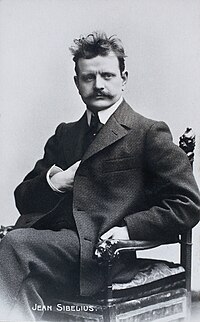The Breaking of the Ice on the Oulu River (in Swedish: Islossningen i Uleå älv; in Finnish: Jäänlähtö Oulujoesta), Op. 30, is a composition by Jean Sibelius, an "improvisation for narrator, men's chorus and orchestra". Sibelius composed it in 1899 on a poem by Zachris Topelius, a Swedish-language Finnish poet, who had dedicated it to Tsar Alexander II of Russia, thus escaping censorship. The piece was an "explicit protest composition" against a Russia restricting the autonomy of the Grand Duchy of Finland. Sibelius wrote it for a lottery of the Savonian-Karelian Students' Association, where he conducted the first performance on 21 October 1899.
| The Breaking of the Ice on the Oulu River | |
|---|---|
| Melodrama by Jean Sibelius | |
 The composer (c. 1900) | |
| Native name | Islossningen i Uleå älv |
| Opus | 30 |
| Text |
|
| Language | Swedish |
| Composed | 1899 |
| Duration | 12 mins.[1] |
| Premiere | |
| Date | 21 October 1899[2] |
| Location | Helsinki, Grand Duchy of Finland |
| Conductor | Jean Sibelius |
| Performers |
|
Instrumentation

The Breaking of the Ice on the Oulu River is scored for the following instruments and voices,[2] organized by family (vocalists, woodwinds, brass, percussion, and strings):
History
Sibelius composed Islossningen i Uleå älv[a] in a political context. Most of what is now Finland had been part of Sweden until Russia won the territory in the Finnish War and ruled it as a Grand Duchy. It was first autonomous in terms of a parliament, money, and schools in Swedish and Finnish, but Nikolay Bobrikov, the Russian Governor-General, tried to limit these liberties and even proposed schooling only in Russian.[4]
Sibelius composed music as patriotic statements against the restricting censorship, in Islossningen i Uleå älv, first performed on 21 October at a lottery of the Savo-Karelian Students' Association in Helsinki, and in Finlandia, first performed as part of the Press Celebration Music two weeks later.[4]Sibelius conducted the first performance, the premiere. He used the choral theme again for children's choir a cappella, The Landscape Breathes (Nejden andas).[4] After the first performance, Sibelius made a note about the composition, "should be revised", which he later did.[3]
Composition
The breaking of the ice is an annual event in some northern countries, releasing winter and ending immobility. The text for Islossningen i Uleå älv is a poem by Zachris Topelius, a Swedish-language Finnish poet.[4] The poem lists many rivers besides the one in the title, summarizing Finland. He dedicated it to Tsar Alexander II, thus protecting it from censorship.[4] Sibelius, like the poet, interpreted the frozen river as a symbol of the Russian oppression, and the breaking of the ice as an image of freedom. Sibelius confirmed the underlying meaning of the music when he programmed its premiere to be followed by Song of the Athenians, a song for freedom first performed half a year earlier and held high by Finnish nationalists.[4]
The composition is subtitled "improvisation for narrator, men's chorus and orchestra".[5] The subtitle is Sibelius' own description of the work, it has otherwise been described as a melodrama, cantata and choir suite.[3] It begins and ends with recitation for the narrator, accented by brass chords. The center of the work is a dramatic chorus, often in unison and accompanied by a symphony orchestra.[4] It has been considered as a test piece for Finlandia in terms of accessibility and some effects of orchestration.[4]
Discography
The Finnish conductor Rauno Rännäli and the Oulu Conservatory Orchestra made the world premiere studio recording of The Breaking of the Ice on the Oulu River—albeit of a Finnish-language translation—in 1990; the male choir was Pohjan Laulu, while the narrator was the Finnish baritone Hannu Heikkilä.[2] The table below lists this and other commercially available recordings::
| No. | Conductor | Orchestra | Chorus | Narrator | Rec.[b] | Time[c] | Venue | Label | Ref. |
|---|---|---|---|---|---|---|---|---|---|
| 1 | Rauno Rännäli | Oulu Conservatory Orchestra | Pohjan Laulu | Hannu Heikkilä | 1990 | 9:54 | Madetoja Hall, Oulu Music Centre | PL | |
| 2 | Osmo Vänskä | Lahti Symphony Orchestra | Jubilate Choir | Lasse Pöysti | 2001 | 10:30 | Sibelius Hall | BIS |
In addition, the Finnish choral director Hannu Norjanen and the Tapiola Chamber Choir made the world premiere studio recording of The Landscape Breathes for female choir a cappella c. 1997 for Finlandia.[2] The table below lists this and other commercially available recordings:
| No. | Choral director | Ensemble | Runtime[c] | Rec.[b] | Recording venue | Label | Ref. |
|---|---|---|---|---|---|---|---|
| 1 | Hannu Norjanen | Tapiola Chamber Choir | 0:40 | 1997 | Roihuvuori Church | Finlandia | |
| 2 | Astrid Riska | Jubilate Choir | 0:52 | 1998 | Tapiola Hall | BIS | |
| 3 | Seppo Murto | Dominante Choir | 0:39 | 2010 | New Pavilon, Kauniainen | BIS | |
| 4 | Heikki Seppanen | Estonian Philharmonic Chamber Choir | 0:31 | 2014 | Järvenpää Hall | Ondine |
Notes
References
Literature
- Mäkelä, Tomi (2013). Jean Sibelius und seine Zeit [Jean Sibelius and his time]. Große Komponisten und ihre Zeit (in German). Regensburg: Laaber-Verlag.
- Dahlström, Fabian [in Swedish] (2003). Jean Sibelius: Thematisch-bibliographisches Verzeichnis seiner Werke [Jean Sibelius: A Thematic Bibliographic Index of His Works] (in German). Wiesbaden: Breitkopf & Härtel. ISBN 3-7651-0333-0.
